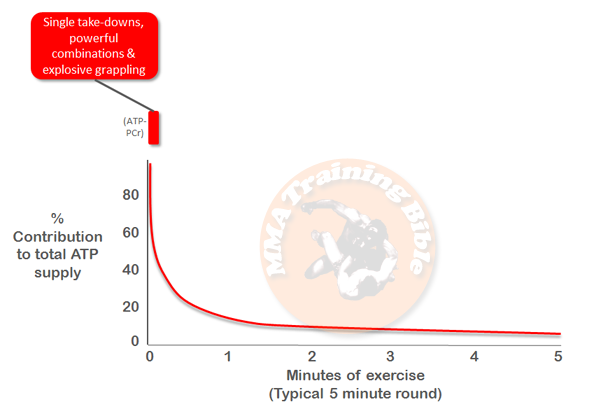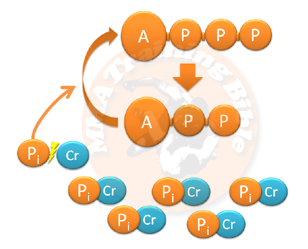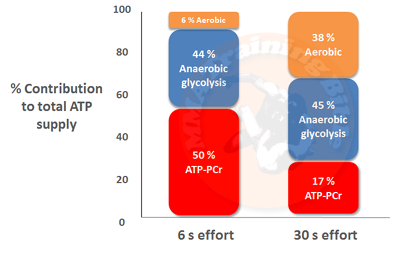Before you read this article, make sure you get up to speed with Part 1 in the series.
….
Understanding the metabolic demands of mixed martial arts (MMA) is the first step in designing a scientific training plan. If you don’t know which energy systems support your activity in the cage, or why you fatigue and gas-out, you may be targeting the wrong energy systems in training. This could lead to overtraining or undertraining, inappropriate development of the aerobic or anaerobic energy systems, or poor development of muscular strength and power. With an understanding of the metabolic demands of MMA, you will be able to stimulate specific physiological and biochemical adaptations that will optimize your performance on fight day. What better motivation do you need to read this series of articles than this?
In Part 1 of this article series examining the metabolic demands of MMA, you learned about the basics of energy transfer. These concepts will serve as the foundation on which the remainder of the article is built, so I advise you to go back and re-read it if you are a bit confused. Part 2 will focus on the ATP-PCr energy system, which is responsible for supporting short explosive efforts in the cage, like take-down attempts or powerful combinations. The main objectives of this section are to, 1) teach you how this system works; 2) show you how to target it with exercise; 3) list the physiological and biochemical adaptations that may occur when you train it. Let’s jump right into the first objective.
How the system works
The ATP-PCr system supports short explosive efforts lasting 0 s to 30 s, like take-downs, powerful combinations, or other explosive grappling movements; this is shown below in Fig 3.
 Fig 3. The ATP-PCr system supports maximal activity in the 0 s to 30 s rang, like take-downs, powerful combinations, or other explosive grappling movements.
Fig 3. The ATP-PCr system supports maximal activity in the 0 s to 30 s rang, like take-downs, powerful combinations, or other explosive grappling movements.The ATP-PCr system is sometimes called the phosphagen system, or the anaerobic alactic system, but I’m going to refer to it as the ATP-PCr system, because I think that name best describes how it works. The first part of the name i.e. ATP, stands for Adenosine Tri Phosphate, which is a high energy molecule made up of adenosine and three phosphates. The second part of the name i.e. PCr, stands for PhosphoCreatine, which is a molecule made up of phosphate and creatine.
As a side note, you may have heard of creatine before. When you supplement your diet with it, you can increase the amount of PCr in the muscle. Although this may improve an athletes’ performance in short explosive sports like the 200 m sprint; its usefulness in MMA, a weight-class sport characterized by repeated high intensity efforts, is not entirely clear, but that’s a topic for another article.
So how does the ATP-PCr system support maximal efforts in the 0 s to 30 s range? First, recall from the energy transfer article that when ATP loses its third phosphate, energy is released and this energy is used to power muscle contraction. The important thing to remember is that during this process of energy release, ATP (which has three phosphates) is converted into Adenosine Di Phosphate (ADP) (which only has two phosphates). Recall that ATP is required for muscle contraction, so ADP must find and join with a third phosphate so that it can be converted back into the high energy ATP molecule. ADP receives this third phosphate from phosphocreatine. Specifically, the PCr molecule splits in two, leaving one creatine and one free phosphate. This free phosphate then joins ADP and creates a new high energy ATP molecule which is used to power your high intensity efforts in the cage. This whole process is shown below in Fig 4.
 Fig 4. Inside your muscle, the pool of phosphocreatine (PCr) is the immediate source for the regeneration of ATP during short explosive movements in MMA. PCr splits into creatine and phosphate and this ‘free’ phosphate is used to convert ADP back to ATP. This allows your muscles to continue contracting at a high intensity during your fight.
Fig 4. Inside your muscle, the pool of phosphocreatine (PCr) is the immediate source for the regeneration of ATP during short explosive movements in MMA. PCr splits into creatine and phosphate and this ‘free’ phosphate is used to convert ADP back to ATP. This allows your muscles to continue contracting at a high intensity during your fight.There is about three to five times as much PCr in your muscle as there is ATP (3, 7). Despite this, your entire pool of PCr can be depleted in 15 s to 30 s of maximal effort (7) and it can take more than five minutes of rest to restore it (1, 9). As recovery time between actions in a bout of MMA does not normally exceed 60 s, even between rounds, it seems likely that the PCr stores in your muscle will only be partially restored before the next effort. This will probably result in a reduction in your power output over repeated efforts, and a drop in your performance as the fight goes on. Separate from the depletion of the PCr pool, there are other factors that may contribute to your fatigue in the cage. Recall from the first article in this series that when ATP is broken down, hydrogen ions and phosphates build up inside the muscle. When you work very hard, ATP is broken down very quickly. This causes a large build-up of hydrogen ions and phosphate inside the muscle. This build-up of hydrogen ions and phosphates will probably impair muscle contraction (8, 10) and hurt your performance in the cage.
As a side note, the aerobic energy systems are essential for resupplying the pool of PCr after it has been deplete, and if you have a high level of aerobic fitness, you should be able to more rapidly replace PCr between repeated efforts (4, 5). A high level of aerobic fitness also means that you will become less reliant on the anaerobic energy systems to produce ATP during high intensity efforts in the cage (6, 7). These are just a few reasons why The MMA Training Bible places so much importance on the aerobic energy systems.
Targeting the ATP-PCr system with exercise
The ability to perform short explosive movements offers a distinct advantage in MMA, so fighters and coaches should dedicate a proportion of their training time to targeting the ATP-PCr system.
To target a specific energy system, you can manipulate the work-to-rest ratios, the work interval length, and the rest period. This form of training is commonly referred to as interval training and it can be used to target both aerobic and anaerobic energy systems. Interval training should be contrasted with longer duration lower intensity training, which can be used to effectively target the aerobic energy systems, but it is not very useful when targeting the anaerobic energy systems. In this series of articles, The MMA Training Bible will provide you with examples of interval training workouts.
Targeting the ATP-PCr system will improve the power of short explosive movements in the cage. To target this system, use work intervals in the 0 s to 30 s range, combined with work-to-rest ratios of 1:10 or greater (6, 7). Typical workouts that target the ATP-PCr system might look something like this: 15 x (5 s on, 70 s off, with 30 s of build-up). There are a lot of variations, so if you’re looking for a full explanation, consider enrolling in our FREE training course on the bioenergetics of MMA. You’ll be taken through a step-by-step process for building your very own training plan. In any case,engaging in these workouts will result in very fast metabolic and physiological gains, but you cannot train at such a high intensity for very long because it takes a long time to recover from each session, and it can result in overtraining. Further, you must have a solid base of aerobic endurance before you progress to high intensity anaerobic interval training. This means that your endurance must be developed in different phases across your fight plan. The organization of your training plan across weeks, months and even years falls in the area of periodization, of course, all this is covered in our MMA Bioenergetics course.
Training adaptations
There is large variation in training adaptations between individuals. Said alternatively, even though everyone on your team is doing the same type of training, not everyone will see the same physiological and biochemical adaptations. This is because training adaptations are influenced by your age, gender, training history, training status, and by your genetics.
Although the ATP-PCr system does not respond as much to training as the other energy systems, a number of adaptations may present (6, 7). For example, you may experience an increase in ATPase activity; that’s the enzyme responsible for the breakdown of ATP to ADP, and the regeneration of ATP from ADP. You may also see an increase in creatine kinase activity; that’s the enzyme which splits apart PCr. These adaptations will increase the rate of ATP turnover and improve your power output during short explosive efforts. The amount of ATP and PCr in your muscle may also increase, especially if your muscle mass is increases, but it’s not clear whether anaerobic performance will improve as a result.
Myths and misconceptions
It is a common misconception that energy systems work in isolation; for example, as one energy system ‘turns on’, another ‘turns off’. This is not true, all of your energy systems are always working together to power your efforts in the cage. Even the aerobic energy systems contribute to ATP production during short explosive efforts. For example, during a single 6 s maximal effort, like a take-down attempt or a powerful combination, about 50 % of the ATP comes from the ATP-PCr system, 44 % comes from anaerobic glycolysis, with the remainder coming from aerobic energy systems (2). As the duration of your maximal effort approaches 30 s, only 17 % of the ATP is provided by the ATP-PCr system, 45 % comes from anaerobic glycolysis, and 38 % comes from aerobic energy systems (6). This is shown below in Fig 5.
 Fig 5. All of the energy systems work together to produce ATP, even during short explosive movements.
Fig 5. All of the energy systems work together to produce ATP, even during short explosive movements.One interesting thing to note about this figure is that during a single 6 s maximal effort, the aerobic systems contribute very little to the total ATP supply, but as you extend your effort to 30 s, the aerobic energy systems produce about 40 % of the total ATP. To put this in perspective, you’re not even 1 minute into the first round of your fight, but your aerobic energy systems are beginning to dominate. Given a typical MMA bout is scheduled to last 15 to 20 minutes, this research supports the notion that MMA is dominated by the aerobic energy systems.
Take-home messages from Part 2
- Understanding the metabolic demands of MMA is the first step in designing a scientific training plan.
- The ATP-PCr system supports short explosive efforts lasting 0 s to 30 s, like take-downs, powerful combinations, or other explosive grappling movements.
- Inside your muscle, the pool of phosphocreatine (PCr) is the immediate source for the regeneration of ATP during short explosive movements in MMA. PCr splits into creatine and phosphate and this ‘free’ phosphate is used to convert ADP back to ATP. This allows your muscles to continue contracting at a high intensity during your fight.
- The aerobic energy systems are essential for resupplying the pool of PCr, and if you have a high level of aerobic fitness, you should be able to more rapidly replace PCr between repeated efforts. This will improve your performance on fight day.
- The ability to perform short and explosive movements offers a distinct advantage. For this reason, fighters and coaches in MMA should dedicate some training time to targeting the ATP-PCr system.
- To target this system, use work intervals in the 0 s to 30 s range, combined with work-to-rest ratios of 1:10 or greater. Be sure to use the appropriate periodization principles when incorporating these workouts into your overall fight plan.
- ATP-PCr training adaptations relate to improving the power of single efforts, like take-down attempts, powerful combinations and explosive grappling.
- All energy systems work together to power your efforts in the cage, although the aerobic energy system probably dominates energy production.
Click here to check out the next article in the series: Part 3.
Part 2 References
- Bogdanis et al., J Physiol 482:467-80 (1995)
- Gaitanos et al., J Appl Physiol 75:712-9 (1993)
- Gollnick & King Med Sci in Sports 1(1):23-31 (1969)
- Harris et al., Pflugers Arch 367:137-142 (1976).
- Haseler et al., J Appl Physiol 86:2013-8 (1999)
- Kreamer WJ, Fleck SJ, Deschenes MR. (2012). Exercise Physiology: Integrating Theory and Application. Lippincott Williams & Wilkin: China.
- Plowman SA, Smith DL. (2011). Exercise Physiology: For Health, Fitness, And Performance (3rd ed.). China: Lippincott Williams & Wilkins.
- Spriet et al., J Appl Physiol 66:8-13 (1989)
- Tomlin & Wenger Sports Med 31:1-11 (2001)
- Westerbalad et al., News Physiol Sci 17:17-21 (2002)

Leave a Reply